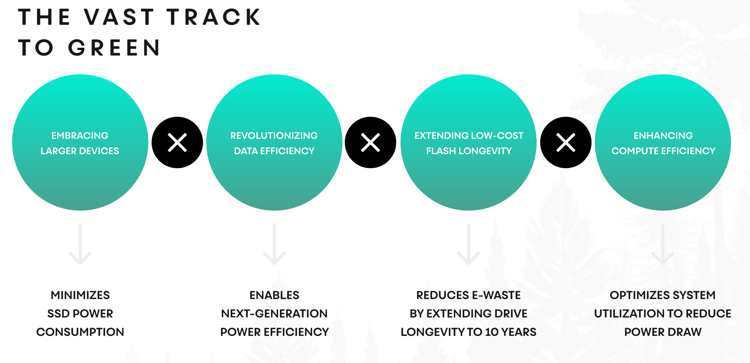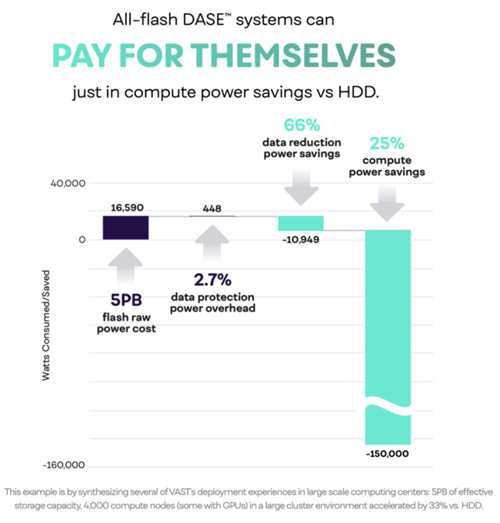Vast Data Sustainability Report on Universal Storage Platform
Guarantees best power consumption, and minimizes e-waste, delivers up to 90% energy cost savings vs. legacy systems.
This is a Press Release edited by StorageNewsletter.com on September 19, 2022 at 2:01 pmVast Data Ltd. released its first Sustainability Report, a data-driven breakdown of how the company’s Universal Storage platform sets the foundation for an environmentally conscious, high-performance data center.
Across the industry, vendors have employed sleight of hand to greenwash products, a practice which happens more frequently with the rise of the energy-conscious enterprise. In this new report, the company disambiguates the topic and brings real data to the table to help customers and partners understand the implications of data systems architecture.
Organizations around the world are facing 2 significant challenges: a rapid increase in the amount of data they’re required to manage and compute on, and a growing emphasis on sustainable business practices led by policymakers and stakeholders. Bridging the gap between these seemingly disparate objectives requires data infrastructure that can deliver the right combination of low-power, efficient performance and compelling economics.
The firm delivers up to 90% energy cost savings over a 10-year span for a 5PB cluster when compared to legacy solutions, and can save up to 50% vs. other flash and hybrid storage products when comparing against other new options. Additionally, as customers realize the power of AFA to accelerate their applications, servers also improve in efficiency in the range of 25 to 50%, particularly for transactional, interactive, analytical and machine learning workloads. Since servers are commonly the largest consumers of energy within a data center, this level of compute efficiency realized by the company’s customers results in an additional level of energy savings that is often many factors greater than what is saved on storage alone.
“Next gen all-flash doesn’t just provide new opportunities to realize significant storage power efficiency gains, but the conversion to scalable silicon storage also makes compute resources much more efficient. The result: even greater power savings across the data center,” said Jeff Denworth, CMO and co-founder.
4 pillars of green data center infrastructure
The Universal Storage architecture unlocks several innovations that drive meaningful and compounding environmental benefits into the data center.
Universal Storage features:
-
Support for high-density hyperscale flash featuring TBs/watt
-
Radical storage savings to realize factors of power savings from data reduction methods
-
Low-cost flash with 10 years of endurance to avoid refresh events and save on e-waste
-
Enhanced compute efficiency by democratizing all-flash to reduce server power draw such that compute-level energy cost savings (alone) can pay for the firm’s system investments
Comparing Universal Storage platform to legacy hybrid systems, company’s storage clusters can cut electricity consumption by nearly 400,000kWh/year, eliminating approximately 283 metric tons of annual CO² production per 5PB deployed. While electricity prices vary by market, it yields massive savings for customers around the world over a 10-year span – to the tune of more than $500,000 in USA, and more than $1 million in power-constrained countries throughout Europe.
“We believe that within 2 to 3 years, power efficiency will become one of the top 5 criteria for enterprise IT infrastructure purchase decisions for organizations with large on-premises IT infrastructure requirements,” said Eric Burgener, research VP, infrastructure systems, platforms and technologies group, IDC. “There is a real difference in the power and cost efficiency of different architectures, just as there is a real difference in scalability. Enterprises would be well-advised to review the architectural differentiators of Vast Universal Storage and how they enable compelling sustainability power efficiencies in the data center.”
According to the United Nations Global E-waste Monitor, electronic waste is one of the fastest-growing waste streams around the world, expected to surpass 74 megatonnes by 2030.
“The data center space is one of the fastest-growing sources of electricity usage and CO² emissions, at a time when energy costs are rising and ESG pressures are becoming more common,” said Pavel Molchanov, managing director and equity research analyst, renewable energy and clean technology group, Raymond James and Associates, Inc. “Data center technologies that can reduce the carbon footprint represent a valuable contribution to the broader decarbonization trend.”
Because the company’s systems are designed to last for at least a decade, customers can minimize e-waste as part of their larger corporate sustainability efforts. The asymmetric design of the firm’s solution architecture eliminates such e-waste, allowing customers to expand their cluster across multiple generations of hardware.
“Sustainability is a central pillar of this institution’s strategy. When weighing our options on how to modernize our data infrastructure to better serve students and faculty, it was crucial that we factored carbon reduction and waste mitigation into the selection process,” said John Askew, IT platform architect, University of Auckland. “Moving to all-flash and partnering with Vast Data was the clear choice, as Universal Storage allowed us to simultaneously uphold our commitments to environmentally conscious operations and technological innovation.”
 Another real-world example is the work being done by the National Renewable Energy Laboratory (NREL). NREL is transforming energy through the research, development, commercialization and deployment of renewable energy and energy efficiency technologies. Its mission is to be one of the most energy efficient data centers in the world, and continues to evaluate and deploy breakthrough data storage solutions that enable next generation efficiencies, minimize power consumption and optimize system utilization to reduce power draw. A solution that meets these needs, as well as providing the highest performance, efficient capacity utilization, and be a ‘campaign storage’ that utilizes IB and Ethernet interfaces with a simple S3 and NFS-style mount for its on-premise data requirements, has proven to be desirable and easy to implement across all systems, with minimal system administrator resources.
Another real-world example is the work being done by the National Renewable Energy Laboratory (NREL). NREL is transforming energy through the research, development, commercialization and deployment of renewable energy and energy efficiency technologies. Its mission is to be one of the most energy efficient data centers in the world, and continues to evaluate and deploy breakthrough data storage solutions that enable next generation efficiencies, minimize power consumption and optimize system utilization to reduce power draw. A solution that meets these needs, as well as providing the highest performance, efficient capacity utilization, and be a ‘campaign storage’ that utilizes IB and Ethernet interfaces with a simple S3 and NFS-style mount for its on-premise data requirements, has proven to be desirable and easy to implement across all systems, with minimal system administrator resources.
Vast’s Sustainability Guarantee
Talk is cheap and the climate clock is ticking. If a customer can achieve better environmental and economic results from a technically comparable, modern data infrastructure platform, the company will cover the difference in the form of carbon offset credits. Read the report for additional details behind Vast’s sustainability guarantee.
“When you combine Vast’s approach to crucial areas such as energy efficiency and e-waste reduction, we’re answering the call to today’s energy-conscious enterprises with a, now guaranteed, solution to provide best-in-class infrastructure efficiency and longevity,” added Denworth.
Resources:
Vast Sustainability Report: A Modern Approach to Data Center Infrastructure Efficiency
Blog :It’s Not Easy Being (Really) Green
















 Subscribe to our free daily newsletter
Subscribe to our free daily newsletter
